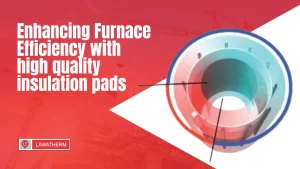In any induction furnace, performance starts with the coil. The coil is the heart of the system, generating the electromagnetic field that heats the metal. But without proper induction coil insulation, that heart can’t beat for long. Coil damage, energy loss, and frequent breakdowns often trace back to poor insulation.
You may overlook insulation, but it directly affects your furnace’s power use, safety, and output. If you’re aiming for better productivity, keeping your coils insulated should be a priority.
What Is Induction Coil Insulation?
Induction coil insulation is a high-temperature material applied over the induction coil. It acts as a thermal and electrical barrier between the coil and its surroundings. The insulation can be ceramic-based or fiber-based, depending on the coil’s temperature range and design.
In induction furnace components, the coil generates intense heat and electromagnetic waves. Without insulation, these forces can degrade the coil material or escape into other parts of the furnace. Insulation helps control the temperature, reduce stray losses, and extend the coil’s life.
Why Insulation Matters
- Coil Overheating Prevention
Overheating coils is one of the most common failures in induction systems. Poor insulation allows heat buildup in the copper windings, which can lead to cracking or deformation. Insulation manages the heat flow and helps the coil cool down uniformly. This improves safety and keeps the coil functional for longer periods. - Thermal Loss Reduction
If you run a steel plant, you’re aware of the high power costs. Poor insulation lets heat escape into the furnace shell, increasing energy needs. With proper induction coil insulation, you trap that heat where it belongs—inside the working zone. This means faster melt rates and less electricity used. - Improved Furnace Control
When your coils maintain stable temperatures, you gain better control over your process. Insulation helps keep temperature swings under check. This results in more uniform metal heating, which reduces scrap and improves material quality. - Electrical Isolation
The furnace environment is full of metal, dust, and moisture. Without insulation, a coil can cause shorts or arcing. Ceramic insulation acts as a protective layer, separating the coil from contact with other parts. This protects your system from unwanted electrical discharge and damage.
Materials Used in Coil Insulation
There’s no one-size-fits-all solution for coil insulation. The material you choose depends on your operating conditions. Some common choices include:
- Ceramic insulation: High thermal resistance, often used in coreless induction furnaces. It can handle very high temperatures and doesn’t degrade easily.
- Glass fiber sleeves: Used for medium-temperature applications, often as a wrap over ceramic for double protection.
- Mica sheets: Excellent for dielectric strength, often layered between the coil and insulation wrap.
Each material brings its own benefits. For example, ceramic wraps are best for high-temp insulation, while mica helps with electrical barriers. A mix of these materials is often used for full coverage.
Signs Your Insulation Is Failing
- Visible cracks or wear in the insulation surface
- Hot spots on the coil during operation
- Fluctuations in melt times or power consumption
- More frequent coil replacements
- Smell of burning materials near the coil area
If you notice these signs, shut down and inspect the coil. Damaged insulation should never be patched temporarily. Always replace it with suitable high-temperature material.
Coil Insulation in Steel Plants
In steel production, where furnaces run for long hours, coil overheating prevention is critical. At Lawatherm, we’ve seen clients reduce their downtime just by upgrading their induction coil insulation. One plant replaced low-grade wraps with our high-strength ceramic insulation and saw a 20% drop in energy use. Their coils also lasted three times longer.
When you plan your induction furnace components, factor in not just the coil design but the insulation layout. Use wraps, covers, and fillers to seal off all potential leak paths.
Maintenance Tips
- Inspect coils monthly for signs of insulation wear
- Replace worn materials before the coil degrades
- Avoid using water directly on hot insulation to prevent cracking
- Store spare insulation material in dry, cool places
- Choose insulation rated for higher temperatures than your furnace operates at
Never treat insulation as a one-time task. It’s part of your ongoing furnace health plan.
Why Choose Lawatherm?
Lawatherm understands how small parts like insulation affect your furnace’s performance. We supply quality induction furnace components, including reliable induction coil insulation solutions. From ceramic insulation to custom sleeves, we tailor insulation to your furnace needs.
Our products help you tackle coil failures, reduce energy loss, and extend furnace life. If your coil performance isn’t consistent, it may not be a design flaw—it could be the insulation.
Don’t wait for a breakdown. Let Lawatherm help you improve your system before problems start.
Final Thoughts
Even the best induction coils won’t perform well without the right insulation. Every degree of lost heat is wasted energy. Every damaged coil means lost production time. Invest in strong induction coil insulation. You’ll lower costs, improve melt quality, and avoid shutdowns. Start with the right insulation, and your furnace will deliver better results. Trust Lawatherm to supply what your system truly needs.




